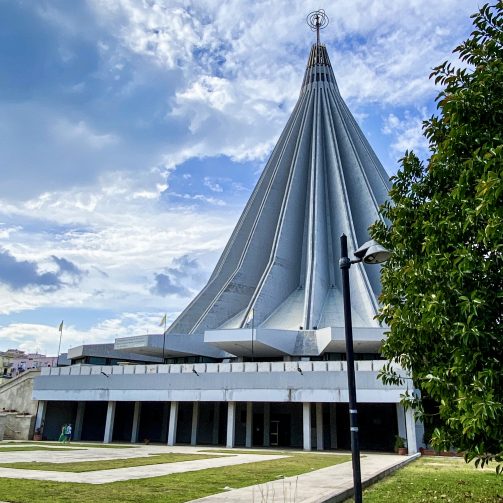The Basilica Santuario Madonna delle Lacrime in Syracuse is one of the main places of Marian worship in Italy, built to welcome pilgrims attracted by the miracle of the tearing of the effigy of Our Lady that occurred in 1953.
To honor this extraordinary event, an international architectural competition was announced, in which 100 architects from 17 countries participated: the French Michel Andrault and Pierre Parat won. Work began in 1988 and was completed in 1994 with the solemn dedication by St. John Paul II.
103 meters high, the Basilica presents a modern and evocative form, interpreted as a tent, a beacon, a tear or man’s impetus toward God. It can accommodate up to 6,000 people standing and 4,000 seated. A gilded bronze statue of Our Lady, 3 meters high and weighing 600 kg, by Francesco Caldarella, stands out at the apex. The interior, featuring a single large marble-clad hall, houses a Modica stone altar carved by Giancarlo Marchese, surmounted by an 18th-century crucifix. Behind the high altar is the miraculous painting of Our Lady of Tears.
The basilica also includes 16 side chapels dedicated to various saints and religious themes, and a majestic bronze doorway by Giacomo Albano decorated with Gospel scenes on the theme of the “door” (Jn. 10:9).
On the lower level is the Crypt, normally closed to the public and open only on special occasions, such as the Monumenti Aperti event. Opened in 1968, it has a circular shape with an external diameter of 80 meters and a seating capacity of 2,000. Inside it houses several chapels (of the Sacred Heart, of the Reconciliation, of Saints Peter and Paul for the Orthodox rite, and of Saint Lucy), the Museum of Ex votos and, in the center, the altar with the Reliquary containing the authentic Tears of the Virgin Mary.
Also of special note is the “Christ of Light” crucifix by Francesco Scialfa and a late Byzantine hypogeum, evidence of the site’s ancient Christian roots.
Also on the lower level, the Museum of the Tearing documents the 1953 miracle through photographs, films, articles, official documents and testimonies. One section is dedicated to the historic visit of St. John Paul II in
1994.
During the special opening days, during the indicated time slots, it will be possible to participate in special guided tours that will take visitors on an in-depth tour through the Crypt and the Museum of Lacrimation. The meeting point is set at the courtyard in front of the entrance to the lower level of the Basilica, where an initial introduction will present the history and architecture of the Shrine. The route will then wind through the devotional, archaeological and museum spaces of the complex, offering an immersive experience that combines faith, art and memory.









